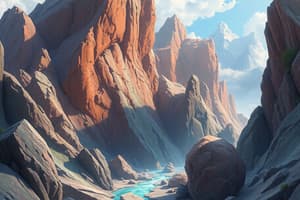Podcast
Questions and Answers
Which of the following minerals contains the sulfate anion (SO4)2-?
Which of the following minerals contains the sulfate anion (SO4)2-?
- Gypsum (correct)
- Flint
- Pyrite
- Coal
What type of rock is formed by volcanic activity through the solidification of molten rock material?
What type of rock is formed by volcanic activity through the solidification of molten rock material?
- Foliated
- Metamorphic
- Sedimentary
- Igneous (correct)
Which of the following is not classified as a chemical sedimentary rock?
Which of the following is not classified as a chemical sedimentary rock?
- Chert
- Limestone
- Shale (correct)
- Iron ore
Which minerals belong to the category of sulfides?
Which minerals belong to the category of sulfides?
Which rock type is characterized by having a layered or banded appearance due to heat and directed pressure?
Which rock type is characterized by having a layered or banded appearance due to heat and directed pressure?
What is an example of a native element mineral?
What is an example of a native element mineral?
Which of the following is considered an organic sedimentary rock?
Which of the following is considered an organic sedimentary rock?
Which type of igneous rock solidifies on the earth’s surface after a volcanic eruption?
Which type of igneous rock solidifies on the earth’s surface after a volcanic eruption?
What defines a mineral?
What defines a mineral?
Which of the following best describes rocks?
Which of the following best describes rocks?
Which property of minerals indicates how they break along specific planes?
Which property of minerals indicates how they break along specific planes?
What does the term 'streak' refer to in mineralogy?
What does the term 'streak' refer to in mineralogy?
Which classification of minerals contain silicon and oxygen?
Which classification of minerals contain silicon and oxygen?
Which process describes how rocks are formed?
Which process describes how rocks are formed?
What characteristic distinguishes oxides from other minerals?
What characteristic distinguishes oxides from other minerals?
Which of the following minerals is categorized as a silicate?
Which of the following minerals is categorized as a silicate?
Flashcards are hidden until you start studying
Study Notes
Minerals
- Minerals are naturally occurring, inorganic solids with a specific chemical composition and crystalline structure.
- They are the fundamental building blocks of rocks found in the Earth’s crust.
- Key properties of minerals include luster, hardness, color, streak, crystal form, cleavage, and fracture.
- Unique identification properties include magnetism, odor, taste, tenacity, and reaction to acid.
Properties of Minerals
- Luster: Quality and intensity of reflected light.
- Hardness: Resistance to abrasion.
- Color and Streak: Distinct colors can identify minerals; streak is the mineral's powdered color.
- Crystal Form/Habit: External shape observed during crystal growth.
- Cleavage: Ability to break along parallel planes, resulting in smooth surfaces.
- Fracture: Irregular breakage with non-planar surfaces.
Classification of Minerals
- Silicates: Contain silicon and oxygen (e.g., quartz, feldspar).
- Oxides: Composed of oxygen and one or more metal ions (e.g., hematite, sapphire).
- Sulfates: Contain sulfur and oxygen anions (e.g., baryte, gypsum).
- Sulfides: Contain sulfur anions (e.g., pyrite, galena).
- Carbonates: Include carbonate ions (e.g., calcite, dolomite).
- Native Elements: Form as individual elements; metals (e.g., gold), semi-metals (e.g., arsenic), nonmetals (e.g., sulfur).
- Halides: Contain halogen elements (e.g., halite).
Rocks
- Rocks are solid combinations of mineral formations.
- Classified into three main types: igneous, sedimentary, and metamorphic.
Igneous Rocks
- Formed through volcanic activity and solidification of molten rock.
- Intrusive Igneous Rocks: Crystallize below Earth's surface (e.g., granite, diorite).
- Extrusive Igneous Rocks: Solidify on the surface post-eruption (e.g., basalt, pumice).
Sedimentary Rocks
- Created through sedimentation and deposition of materials.
- Clastic Sedimentary Rocks: Formed from mechanical weathering debris (e.g., sandstone, shale).
- Chemical Sedimentary Rocks: Formed when dissolved materials precipitate (e.g., limestone).
- Organic Sedimentary Rocks: Result from accumulation of plant or animal debris (e.g., coal).
Metamorphic Rocks
- Formed through heat, pressure, and chemical processes while buried deep beneath the surface.
- Foliated Metamorphic Rocks: Display a layered or banded appearance due to heat and pressure.
Distinction Between Rocks and Gems
- Rocks are solid aggregates of minerals while gems are precious or semi-precious minerals cut and polished for use in jewelry.
- The lesson from gems is the inherent beauty and value found in natural formations, often requiring transformation to appreciate fully.
Studying That Suits You
Use AI to generate personalized quizzes and flashcards to suit your learning preferences.





